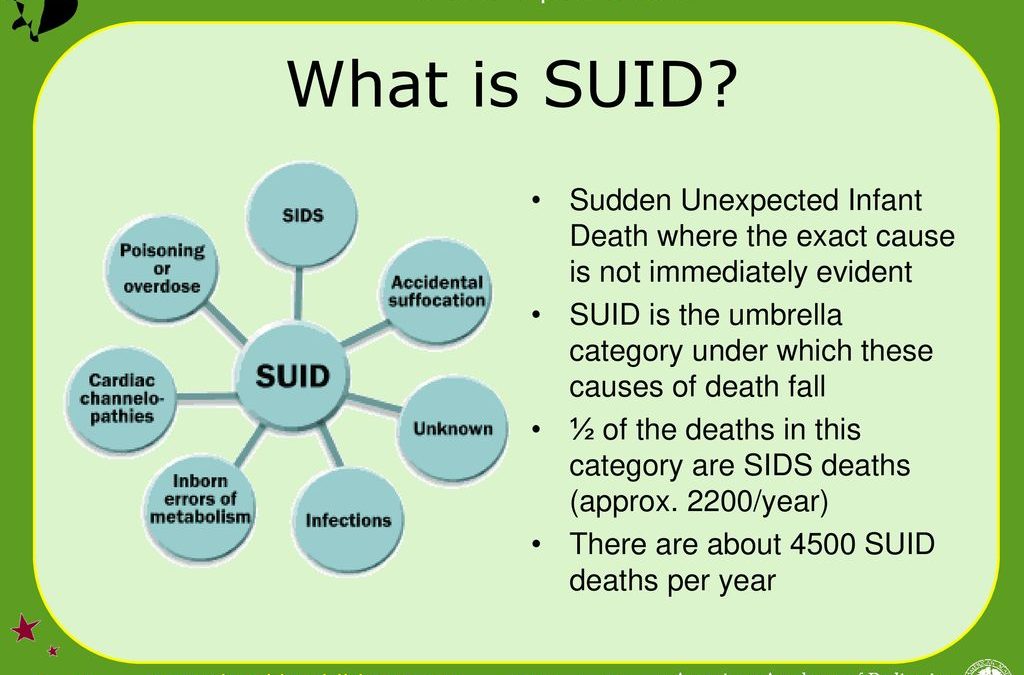-
Best Australian Pokies Best Payout
Play Free 777 Pokies Online
What Are the Best Australian Pokies to Win Big On
What Are the Best Online Pokies with Low Minimum Deposits for Real Money in Australia
New Australian Pokies Accepting PayID
What Are the Best Strategies to Win in Online Pokies with Bonus Rounds in Australia
Tips for Winning Top Australian Pokies
What Online Casinos Offer Free Play Pokies with Welcome Bonuses in Australia
Australian Slot Games
Payout Ratio Pokies with Welcome Bonus

SUID is the umbrella category under which these causes of death fall. ½ of the deaths in this category are SIDS deaths (approx. 2200/year) There are about 4500 SUID deaths per year. Sudden Unexpected Infant Death (SUID) is sometimes called Sudden Unexpected Death in Infancy (SUDI). All causes of death are defined medical disorders that are listed in the International Classification of Diseases, 10th Revision (ICD-10) and used for statistical and research purposes. In recent years, many coroners and medical examiners have begun using the more general term of SUID rather than SIDS because they cannot rule out the possibility that the baby died due to other factors like accidental suffocation. This is called code-shifting . Many coroners will not list an infant death as suffocation due to overlay, entrapment or positional asphyxia unless there is unequivocal evidence such as an eyewitness. If there is no such evidence, these types of suffocation deaths may be listed as SUID, SIDS, or undetermined deaths. Thus, the actual number of deaths due to suffocation may be underreported. Prior to the early 1990s, some metabolic disorder deaths were sometimes misdiagnosed as SIDS deaths. Better testing at autopsy and newborn screening has largely eliminated that problem. Newborn screening has been a highly successful program to identify babies with rare metabolic disorders. Many babies can be saved by proactive identification and treatment. Unknown cause of death is sometimes called Undetermined . This cause of death can be used when no autopsy is allowed due to religious objections. It is also used by coroners who are unable or uncomfortable with identifying another cause of death due to insufficient proof. Poisoning or overdose deaths are frequently Tylenol deaths where the caregiver did not realize that they were giving the incorrect dose or giving two medications that both contained Tylenol. For example, Tylenol for the fever and a cold medication that also included Borchardt Consulting. Use Freely, Do Not Change.
Define both SIDS and SUID in 1500 to 2000 words
Define both SIDS and SUID in 1500 to 2000 words
Write a 1500-2000 word essay . The title page and reference page do not count towards the word count. Answer each of the bulleted points listed below.
• Define both SIDS and SUID
• Contrast the two definitions – Do they both define the same type of infant death?
• What are the differences between investigating an infant death and an adult death? (include developmental issues with your answer)
• Contrast any differences that may exist between the public/general medical community’s understanding of unexplained infant deaths, and the Medical Examiner/Coroner (death investigation) and forensic pathologist’s community position.
• If there are contrasting opinions, discuss why you believe these exist.
• Provide an explanation for why statistical reporting on unexplained infant deaths has shifted from one category to another over recent years.
About SUID and SIDS
Sudden unexpected infant death (SUID) is a term used to describe the sudden and unexpected death of a baby less than 1 year old in which the cause was not obvious before investigation. These deaths often happen during sleep or in the baby’s sleep area. Learn more about the problem and CDC activities.
About 3,400 babies in the United States die suddenly and unexpectedly each year. A thorough investigation is necessary to learn what caused these deaths. Sudden unexpected infant deaths include sudden infant death syndrome (SIDS), accidental suffocation in a sleeping environment, and other deaths from unknown causes. Although the SUID rate has declined since 1990s, significant racial and ethnic differences continue. See Data and Statistics for more information about trends and SUID by race and ethnicity.
Different practices in investigating and reporting SUID can affect the ability to reliably monitor SUID trends and risk factors at the state and national level. Additionally, because parents or caregivers do not usually see these deaths as they happen, investigators may not be able to get a clear description of the circumstances surrounding the death, which are necessary for determining the cause.
CDC’s Division of Reproductive Health (DRH) provides scientific leadership in SUID by sharing the most up-to-date information about SUID rates and circumstances linked with SUID. CDC’s Division of Reproductive Health also has SUID monitoring programs in 22 states and jurisdictions, covering about 1 in 3 SUID cases in the United States. Participating states and jurisdictions work to improve data quality on SUID cases.
This effort leads to a better understanding of circumstances that may increase the risk of SUID. Program awardees also use data about SUID trends and circumstances to carry out strategies to reduce future deaths. In addition, CDC collaborated with a number of organizations and subject matter experts to develop training materials and a reporting form for investigators.
CDC supports the 2016 recommendationsexternal icon issued by the American Academy of Pediatrics (AAP) to reduce the risk of all sleep-related infant deaths. Caregivers can visit How to Keep Your Sleeping Baby Safe: AAP Policy Explainedexternal icon to find out more about these recommendations.
CDC collaborates with the Eunice Kennedy Shriver National Institute of Child Health and Human Development in its Safe to Sleep®external icon campaign, formerly known as the Back to Sleep campaign.
The Safe to Sleep® campaign has outreach activities to spread safe sleep messages and educational materials about ways to reduce the risk of SIDS and other sleep-related infant deaths. Learn more about CDC resources, publications, and activities to address SUID and SIDS.
Attachments
